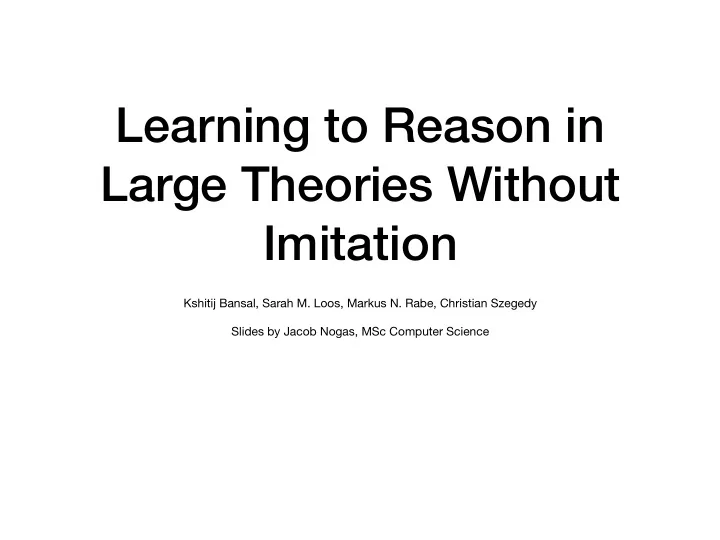

Learning to Reason in Large Theories Without Imitation Kshitij Bansal, Sarah M. Loos, Markus N. Rabe, Christian Szegedy Slides by Jacob Nogas, MSc Computer Science
Outline of Talk 1. Background • ITP terminology • Proof search graph • RL • DeepHOL 2. New approach; imitation learning free • Premise Selection • Experimental results
ITP Terminology • ITP: Interactive theorem prover; human (or ML system) interacts with proof assistant • Goal: provable statement, ie. theorem • Tactic: • Proof step • Represented as ID of preselected manipulation of goal that led to successful proof • Produces a list of subgoals • Success when tactic produces empty list of subgoals • Takes list of previously proven theorems (premise) as optional argument
Proof Search Graph • Captures state of proof search • Allows us to determine if proof for original goal is available • Nodes: goals that have been seen • Edges: tactic application (leads to new goals) • Search for proof of goal by breadth first search
Reinforcement Learning - Framing • Action: choose tactic, as well as premises • State: Proof search graph • State transition: New proof search graph populated with new sub-goals • Reward: successful proof
Previous Work - DeepHOL • Bansal et al. [2019] created the DeepHOL prover proves theorems in ITP setting with reinforcement learning • Rely on imitation learning • Key aspect of their reinforcement learning set up is the action generator network
DeepHOL - Action Generator • During breadth first search, action generator neural network generates a ranked list of tactics and applies them in order • Stops applying tactics when reach maximum number of unsuccessful tactic applications or minimum number of successful applications • Search is stopped when a complete proof is found for the top level goal
Action Generator Details • Ranks tactics in scoring vector , where is linear layer S ( G ( g )) S producing logits of softmax classifier • Ranks previously proven theorems in their usefulness as a tactic argument in transforming current goal towards closed proof
Why use Imitation? • DeepHOL require the use of imitation learning as starting point in exploration • Tactics can refer to definitions and theorems that have been proved, thus the action space is continuously expanding • For example, the “rewrite” tactic performs a search in the current goal for a term to be rewritten by some of the equations provided for the tactic parameters (premises)
Exploring Premises • Premise selection is crucial for good performance • DeepHOL selects premises based on ranking network • Without imitation, DeepHOL runs into issues: • Randomly initialized ranking model fails to learn useful similarity metric for comparing goals and premises • Fails to explore explore premises
Imitation Learning Drawbacks • Learning without imitation learning addresses the key problem of exploration directly • Theorem proving on new proof assistant platforms would require a new training data of existing proofs • Existing proofs may not exist • Performing better than humans requires going beyond imitating that which is achieved by existing human demonstrations
Proposed Solution • This paper proposes a solution to exploring premises which does not use imitation learning • Initialize network by training on a seed dataset for one round of proving with premise selection network that ranks premises by the cosine similarly between goal embedding and premise embedding (from two-tower neural net); are P 1 the top scoring premises k 1 • Add exploration by mixing in new elements to the proposed set of premises. Select premises from , is P 1 ∪ P 2 P 2 selected from one of the methods in the following slide
Selecting P 2 • PET: Cosine similarity as before, but then perturb with random noise, re-rank, and choose top as k 2 P 2 • BoW1: is selected as top scoring premises from P 2 k 2 cosine similarity between randomized bag-of-word (BoW) embeddings of goal and premises weighted by random noise • BoW2: Same as BoW1, but with modification to random weighting (details in appendix)
Experimental Results - Training Set
Experimental Results - Validation Set
Appendix - Premise Selection • Fails when not all conditions are met, tactic cannot be applied
Reference Page 1. Kshitij Bansal, Sarah M Loos, Markus N Rabe, Christian Szegedy, and Stewart Wilcox. Holist: An en- vironment for machine learning of higher-order theorem proving. arXiv preprint arXiv:1904.03241, 2019.
Recommend
More recommend